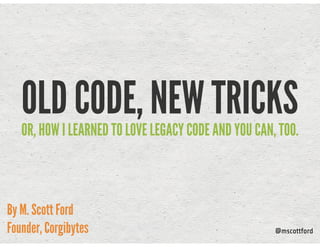
Old Code, New Tricks
- 1. OLD CODE, NEW TRICKSOR, HOW I LEARNED TO LOVE LEGACY CODE AND YOU CAN, TOO. By M. Scott Ford Founder, Corgibytes @mscottford
- 2. @mscottford WHY WAS THIS MY FAVORITE PROJECT?
- 3. @mscottford DISSATISFIED? WHY WAS I SO • Product vs. Services? • Desktop vs. Web? • Startup vs. Enterprise? • Hacker vs. Craftsman? • Self Employed?
- 10. @mscottford MAKERS • Speed to Market • Rapid Prototyping • Minimum Viable Product • Likes Experimenting • Energized by Big Launch
- 11. @mscottford MENDERS • Repair Technical Debt • Reduce Entropy • Bug Fixes & Integrations • Likes Stable & Steady • Energized by Small Wins
- 16. @mscottford DEVELOPER LANDSCAPE HACKER CRAFTSMAN RAPID PROTOTYPING SOLID FIRE FIGHTING MAKING MENDING
- 17. @mscottford DEVELOPER LANDSCAPE HACKER CRAFTSMAN RAPID PROTOTYPING SOLID FIRE FIGHTING ???? MAKING MENDING
- 18. @mscottford DEVELOPER LANDSCAPE HACKER CRAFTSMAN RAPID PROTOTYPING SOLID FIRE FIGHTING SOFTWARE REMODELING MAKING MENDING
- 20. SOFTWARE REMODELING @mscottford activities that reduce software entropy
- 22. @mscottford Modification increases complexity, unless a conscious effort is made. Using software means continuous modification.1 2 Lehman, M. M.; Belady, L.A. (1985), Program evolu=on: processes of soCware change, Academic Press Professional, Inc., San Diego, CA SOFTWARE ENTROPY
- 23. @mscottford The longer it’s been since the last time a program has been modified, the more expensive it will be to make the next modification.
- 26. @mscottford WHEN TO REMODEL? FEATURES YOU HAVE
- 27. @mscottford WHEN TO REMODEL? FEATURES YOU HAVE FEATURES YOU NEED
- 28. @mscottford WHEN TO REMODEL? FEATURES YOU HAVE FEATURES YOU NEED REMODELING JUSTIFICATION
- 31. project? How do you describe a LEGACY @mscottford
- 32. @mscottford WHAT COLOR IS YOUR FIELD?
- 33. • Talking positively about our work helps us feel good about it. • Consider the following: @mscottford LANGUAGE MATTERS NEGATIVE POSITIVE Legacy Brownfield Rescue Spaghetti Code Antiquated Existing Code Restore Remodel Revitalize Vintage/Classic
- 34. • Some terms used by the Agile community begin to break down when talking about existing projects. • Consider the following: – Sprint vs. Iteration – Estimate vs. Forecast @mscottford LANGUAGE MATTERS
- 36. • Would a doctor treat you using only medical knowledge available in the year you were born? • When working on an old house, would you limit yourself to only tools available the year it was built? • You DO NOT have to limit yourself to old tools and techniques. @mscottford USE MODERN TECHNIQUES
- 38. • Look at work as a form of software archaeology. • Practice giving and receiving critiques. • Retrospective Prime Directive becomes invaluable. Reserve judgement. “Regardless of what we discover, we understand and truly believe that everyone did the best job they could, given what they knew at the time, their skills and abilities, the resources available, and the situation at hand.” @mscottford RESPECT THE PAST
- 39. • How to give a good critique: –Critique the code: never the author. –Call attention to the good things, as well as opportunities for improvement. –Make it clear that you are stating opinion and not fact. • Practice at http://exercism.io • git blame @mscottford RESPECT THE PAST
- 40. @mscottford Modern Techniques Systems, Not Goals REMODELING PRINCIPLES Language Matters Respect The Past
- 41. • Goals work great for initial launch, not so well for maintenance. – Ex: Better to establish system where tests are added with every commit than set a “goal” of 100% test coverage. – Continuous Integration – Continuous Deployment – Automated Code Review @mscottford SYSTEMS, NOT GOALS
- 42. • Some of our favorite tools for creating maintenance systems: – Style Cops (rubocop, FxCop) – Linters (jslint, csslint, xmllint) – Quality (Code Climate, BitHound) – Continuous Monitoring (Honeybadger, Airbrake, New Relic) – Continuous Deployment & Integration (CodeShip, Jenkins, Travis CI, Circle CI) – Chat-Ops (Slack, Gitter, HipChat) @mscottford SYSTEMS, NOT GOALS
